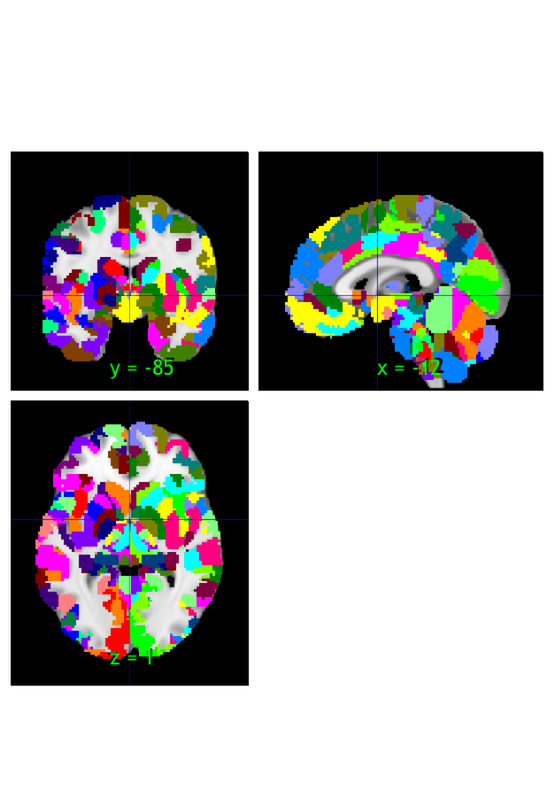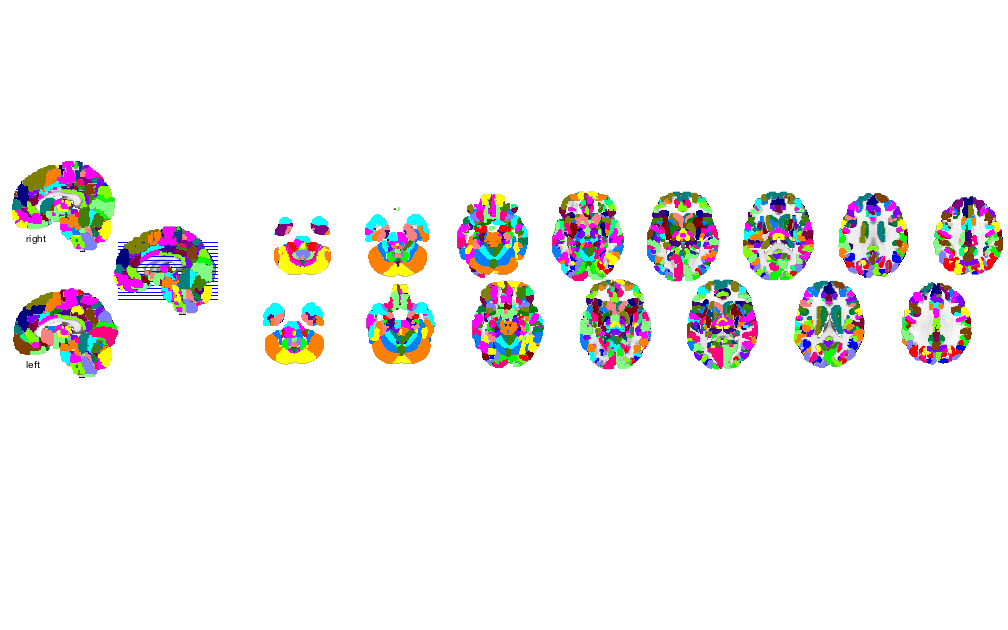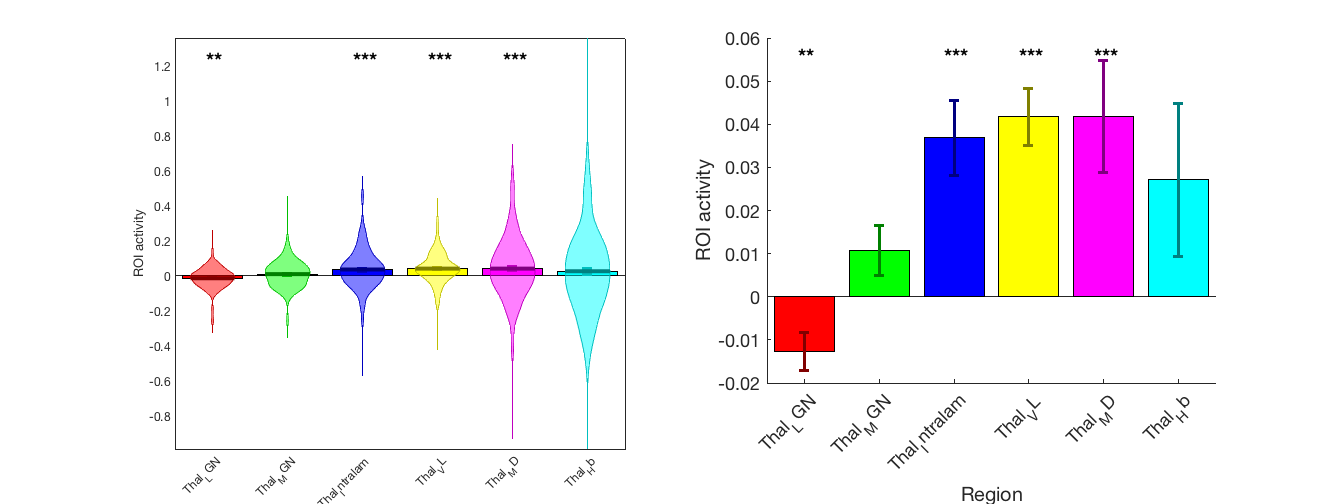Contents
Dependencies:
% Matlab statistics toolbox % Matlab signal processing toolbox % Statistical Parametric Mapping (SPM) software https://www.fil.ion.ucl.ac.uk/spm/ % For full functionality, the full suite of CANlab toolboxes is recommended. See here: Installing Tools
load an atlas
'atlas' objects are a class of objects specially designed for brain atlases. Here is more information on this class (also try >> doc atlas)
help atlas % The function load_atlas in the CANlab toolbox loads a number of named % atlases included with the toolbox. Here is a list of named atlases: help load_atlas % Now load the "CANlab combined 2018" atlas: atlas_obj = load_atlas('canlab2018_2mm');
atlas: Subclass of image_vector designed for brain atlases and parcellations
'atlas' is a data class containing information about brain atlases and parcellations
stored in a structure-like object. It inherits the properties and
methods of fmri_data and image_vector objects.
'atlas' objects are a class of objects specially designed for brain
atlases. They have properties (fields) for probabilistic maps and a data
field (.dat) that contains integer codes for thresholded/maximum
probability labels. There is also a "labels" property with the text
labels for each region, and additional description and label fields for
additional annotation. These can hold, e.g., hierarchical labels at different
levels of spatial resolution. A "reference" property holds information
about associated publications.
Atlas objects have specialized methods for selecting regions by name or
number (including groups of regions with similar names). Because it is a
subclass of the image_vector object, it inherits all of its methods as
well (montage, surface, apply_mask, write, descriptives, flip,
image_similarity_plot, image_math, etc.
The function load_atlas in the CANlab toolbox loads a number of named
atlases included with the toolbox. Type >> help load_atlas for a list of
named atlases.
Creating an atlas object requires either images with probability maps (a 4-d image)
Or an integer-valued image with one integer per atlas region.
For full functionality, the atlas also requires both probability maps and
text labels, one per region, in a cell array. But some functionality will
work without these.
Basic usage for creating a new atlas image:
obj = atlas(image_names, ['mask',maskinput], [other optional inputs])
maskinput : Name of mask image to use. Default: 'brainmask.nii', a
brain mask that is distributed with SPM software
Alternative in CANlab tools: which('gray_matter_mask.img')
'noverbose' : Suppress verbose output
'sample2mask' : Sample images to mask space. Default: Sample mask to
image space, use native image space
Creating class instances
-----------------------------------------------------------------------
You can create an empty object by using:
obj = atlas
- obj is the object.
- It will be created with a standard brain mask, brainmask.nii
- This image should be placed on your Matlab path
- The space information is stored in obj.volInfo
- Data is stored in obj.dat, in a [voxels x images] matrix
- You can replace or append data to the obj.dat field.
You can create an atlas object with extacted image data.
- Let "imgs" be a string array or cell array of image names
- This command creates an object with your (4-D) image data:
- fmri_dat = atlas(imgs);
- Only values in the standard brain mask, brainmask.nii, will be included.
- This saves memory by reducing the number of voxels saved dramatically.
You can specify any mask you'd like to extract data from.
- Let "maskimagename" be a string array with a mask image name.
- this command creates the object with data saved in the mask:
- fmri_dat = atlas(imgs, maskimagename);
- The mask information is saved in fmri_dat.mask
e.g., this extracts data from images within the standard brain mask:
dat = atlas(imgs, which('brainmask.nii'));
Properties and methods
-----------------------------------------------------------------------
Properties are data fields associated with an object.
Try typing the name of an object (class instance) you create to see its
properties, and a link to its methods (things you can run specifically
with this object type). For example: After creating an atlas object
called fmri_dat, as above, type fmri_dat to see its properties.
There are many other methods that you can apply to atlas objects to
do different things.
- Try typing methods(atlas) for a list.
- You always pass in an atlas object as the first argument.
- Methods include utilities for many functions - e.g.,:
- resample_space(fmri_dat) resamples the voxels
- write(fmri_dat) writes an image file to disk (careful not to overwrite by accident!)
- regress runs multiple regression
- predict runs cross-validated machine learning/prediction algorithms
Specialized methods unique to atlas objects include:
atlas Construct a new atlas object given Analyze/Nifti image(s)
Utilities for manipulating atlases:
merge_atlases Add all or some regions from an atlas object to another atlas object (with/without replacing existing labeled voxels)
probability_maps_to_region_index Use dat.probability_maps to rebuild integer vector of index labels (dat.dat)
remove_atlas_region Removes region(s) from atlas, by names or index values
reorder_atlas_regions Reorder a set of regions in an atlas object
select_atlas_subset Select a subset of regions in an atlas by name or integer code, with or without collapsing regions together
split_atlas_by_hemisphere Divide regions that are bilateral into separate left- and right-hemisphere regions
split_atlas_into_contiguous_regions Divide regions with multiple contiguous blobs into separate labeled regions for each blob
threshold Threshold atlas object based on values in obj.probability_maps property
% Extracting information and converting to other object types:
atlas2region Convert an atlas object to a region object
check_properties Check properties and enforce some variable types
get_region_volumes Get the volume (and raw voxel count) of each region in an atlas object
num_regions Count number of regions in atlas object, even with incomplete data
Manipulating labels for atlas regions:
atlas_add_L_R_to_labels Removes some strings indicating lateralization from atlas labels and adds new _L and _R suffixes for lateralized regions
atlas_similarity Annotate regions in an atlas object with labels from another atlas object
Visualization:
isosurface Create a series of surfaces in different colors, one for each region
montage Display an atlas object on a standard slice montage
Attaching additional data
-----------------------------------------------------------------------
The atlas object has a number of fields for appending specific types of data.
- You can replace data in the atlas.dat field. However, should always contain one column vector of integers.
- Attach custom descriptions in several fields to document your object.
- The "history" field stores a cell array of strings with the processing
history of the object. Some methods add to this history automatically.
Examples:
-----------------------------------------------------------------------
parcellation_file = 'CIT168toMNI152_prob_atlas_bilat_1mm.nii'; %'prob_atlas_bilateral.nii';
labels = {'Put' 'Cau' 'NAC' 'BST_SLEA' 'GPe' 'GPi' 'SNc' 'RN' 'SNr' 'PBP' 'VTA' 'VeP' 'Haben' 'Hythal' 'Mamm_Nuc' 'STN'};
dat = atlas(which(parcellation_file), 'labels', labels, ...
'space_description', 'MNI152 space', ...
'references', 'Pauli 2018 Bioarxiv: CIT168 from Human Connectome Project data', 'noverbose');
% Display:
orthviews(dat);
figure; montage(dat);
% Convert to region object and display:
r = atlas2region(dat);
orthviews(r)
montage(r);
Reference page in Doc Center
doc atlas
Load one of a collection of atlases by keyword
atlas_obj = load_atlas(varargin)
List of keywords/atlases available:
-------------------------------------------------------------------------
'canlab2018' 'Combined atlas from other published atlases, whole brain.
'canlab2018_2mm' 'Combined atlas resampled at 2 mm resolution'
'thalamus' 'Thalamus_combined_atlas_object.mat'
'thalamus_detail', 'morel' 'Morel_thalamus_atlas_object.mat'
'cortex', 'glasser' 'Glasser2016HCP_atlas_object.mat'
'basal_ganglia', 'bg' 'Basal_ganglia_combined_atlas_object.mat'
'striatum', 'pauli_bg' 'Pauli2016_striatum_atlas_object.mat'
'brainstem' 'brainstem_combined_atlas_object.mat'
'subcortical_rl', 'cit168' 'CIT168_MNI_subcortical_atlas_object.mat'
'brainnetome' 'Brainnetome_atlas_object.mat'
'keuken' 'Keuken_7T_atlas_object.mat'
'buckner' 'buckner_networks_atlas_object.mat'
'cerebellum', 'suit' 'SUIT_Cerebellum_MNI_atlas_object.mat'
'shen' 'Shen_atlas_object.mat'
'schaefer400' 'Schaefer2018Cortex_atlas_regions.mat'
'yeo17networks' 'Schaefer2018Cortex_17networks_atlas_object.mat'
Examples:
-------------------------------------------------------------------------
atlas_obj = load_atlas('thalamus');
atlas_obj = load_atlas('Thalamus_atlas_combined_Morel.mat');
Loading atlas: CANlab_combined_atlas_object_2018_2mm.mat
visualize the atlas regions
orthviews(atlas_obj); o2 = montage(atlas_obj);
SPM12: spm_check_registration (v6245) 23:43:40 - 04/08/2018
========================================================================
Display <a href="matlab:spm_image('display','/Users/torwager/Documents/GitHub/CanlabCore/CanlabCore/canlab_canonical_brains/Canonical_brains_surfaces/keuken_2014_enhanced_for_underlay.img,1');">/Users/torwager/Documents/GitHub/CanlabCore/CanlabCore/canlab_canonical_brains/Canonical_brains_surfaces/keuken_2014_enhanced_for_underlay.img,1</a>
Grouping voxels with unique mask values, assuming integer-valued mask: 489 regions


select regions of interest
% Select all regions with "Thal" in the label: thal = select_atlas_subset(atlas_obj, {'Thal'}) % Print the labels: thal.labels % Select a few thalamus/epithalamus regions of interest: thal = select_atlas_subset(atlas_obj, {'Thal_Intra', 'Thal_VL', 'Thal_MD', 'Thal_LGN', 'Thal_MGN', 'Thal_Hb'}); thal.labels % Select all the regions with "Thal" in the label, and collapse them into a single region: whole_thal = select_atlas_subset(atlas_obj, {'Thal'}, 'flatten');
thal =
atlas with properties:
atlas_name: 'CANlab_2018_combined'
probability_maps: [352328×17 double]
labels: {1×17 cell}
label_descriptions: {17×1 cell}
labels_2: {1×489 cell}
labels_3: {1×489 cell}
labels_4: {''}
labels_5: {''}
references: [33×485 char]
space_description: 'MNI152 space'
property_descriptions: {1×8 cell}
additional_info: [0×0 struct]
dat: [352328×1 int32]
dat_descrip: []
volInfo: [1×1 struct]
removed_voxels: [352328×1 logical]
removed_images: 0
image_names: 'HCP-MMP1_on_MNI152_ICBM2009a_nlin.nii'
fullpath: '/Users/torwager/Documents/GitHub/Neuroimaging_Pattern_Masks/Atlases_and_parcellations/2018_Wager_combined_atlas/CANlab_2018_combined_atlas_2mm.nii'
files_exist: 1
history: {1×5 cell}
ans =
1×17 cell array
Columns 1 through 4
{'Thal_Pulv'} {'Thal_LGN'} {'Thal_MGN'} {'Thal_VPL'}
Columns 5 through 8
{'Thal_VPM'} {'Thal_Intralam'} {'Thal_Midline'} {'Thal_LD'}
Columns 9 through 13
{'Thal_VL'} {'Thal_LP'} {'Thal_VA'} {'Thal_VM'} {'Thal_MD'}
Columns 14 through 17
{'Thal_AM'} {'Thal_AV'} {'Thal_Hb'} {'Thal_Hythal'}
ans =
1×6 cell array
Columns 1 through 4
{'Thal_LGN'} {'Thal_MGN'} {'Thal_Intralam'} {'Thal_VL'}
Columns 5 through 6
{'Thal_MD'} {'Thal_Hb'}
load a dataset to extract data from for an ROI analysis
The dataset contains data from 33 participants, with brain responses to six levels of heat (non-painful and painful).
Aspects of this data appear in these papers: Wager, T.D., Atlas, L.T., Lindquist, M.A., Roy, M., Choong-Wan, W., Kross, E. (2013). An fMRI-Based Neurologic Signature of Physical Pain. The New England Journal of Medicine. 368:1388-1397 (Study 2)
Woo, C. -W., Roy, M., Buhle, J. T. & Wager, T. D. (2015). Distinct brain systems mediate the effects of nociceptive input and self-regulation on pain. PLOS Biology. 13(1): e1002036. doi:10.1371/journal.pbio.1002036
Lindquist, Martin A., Anjali Krishnan, Marina López-Solà, Marieke Jepma, Choong-Wan Woo, Leonie Koban, Mathieu Roy, et al. 2015. ?Group-Regularized Individual Prediction: Theory and Application to Pain.? NeuroImage. http://www.sciencedirect.com/science/article/pii/S1053811915009982.
This dataset is shared on figshare.com, under this link: https://figshare.com/s/ca23e5974a310c44ca93
Here is a direct link to the dataset file with the fmri_data object: https://ndownloader.figshare.com/files/12708989
The key variable is image_obj This is an fmri_data object from the CANlab Core Tools repository for neuroimaging data analysis. See Canlab Dataset Basics
image_obj.dat contains brain data for each image (average across trials) image_obj.Y contains pain ratings (one average rating per image)
image_obj.additional_info.subject_id contains integers coding for which subjects are in each row of the loaded data object, downloading from figshare if needed
Alternative sample datasets: -------------------------------------------- This dataset will take time to download from figshare if you haven't yet downloaded it. An alternative is to use the dataset included with the CANlab Core toolbox (though the results are less interesting for this example). image_obj = load_image_set('emotionreg');
A second example is a CANlab pain dataset shared on Neurovault. Try this to load it: [files_on_disk, url_on_neurovault, mycollection, myimages] = retrieve_neurovault_collection(504); image_obj = fmri_data(files_on_disk);
fmri_data_file = which('bmrk3_6levels_pain_dataset.mat'); if isempty(fmri_data_file) % attempt to download disp('Did not find data locally...downloading data file from figshare.com') fmri_data_file = websave('bmrk3_6levels_pain_dataset.mat', 'https://ndownloader.figshare.com/files/12708989'); end load(fmri_data_file); descriptives(image_obj);
Did not find data locally...downloading data file from figshare.com
Source: BMRK3 dataset from CANlab, PI Tor Wager
Data: .dat contains 6 images per participant, activation estimates during heat on L arm from level 1(44.3 degrees C) to level 6(49.3), in 1 degree increments.
____________________________________________________________________________________________________________________________________________
Wager, T.D., Atlas, L.T., Lindquist, M.A., Roy, M., Choong-Wan, W., Kross, E. (2013). An fMRI-Based Neurologic Signature of Physical Pain.
The New England Journal of Medicine. 368:1388-1397 (Study 2)
Woo, C. -W., Roy, M., Buhle, J. T. & Wager, T. D. (2015). Distinct brain systems mediate the effects of nociceptive input and
self-regulation on pain. PLOS Biology. 13(1): e1002036. doi:10.1371/journal.pbio.1002036
Lindquist, Martin A., Anjali Krishnan, Marina López-Solà, Marieke Jepma, Choong-Wan Woo, Leonie Koban, Mathieu Roy, et al. 2015.
“Group-Regularized Individual Prediction: Theory and Application to Pain.” NeuroImage.
http://www.sciencedirect.com/science/article/pii/S1053811915009982.
____________________________________________________________________________________________________________________________________________
Summary of dataset
______________________________________________________
Images: 198 Nonempty: 198 Complete: 198
Voxels: 223707 Nonempty: 223707 Complete: 223707
Unique data values: 35583281
Min: -11.529 Max: 7.862 Mean: -0.004 Std: 0.227
Percentiles Values
___________ __________
0.1 -1.529
0.5 -0.88055
1 -0.67632
5 -0.31891
25 -0.087519
50 0.00034864
75 0.087461
95 0.29757
99 0.60449
99.5 0.77676
99.9 1.3177
extract data from each atlas region
- "r" is a region-class object. see >> help region - r(i).dat contains averages over voxels within region i. for n images, it contains an n x 1 vector with average data. - r(i).data contains an images x voxels matrix of all data within region i.
r = extract_roi_averages(image_obj, thal);
% r = extract_roi_averages(data_obj, whole_thal);
fmri_data.extract_roi_averages: Defining mask object. Resampling mask. Grouping voxels with unique mask values, assuming integer-valued mask: 6 regions Averaging data. Averaging over unique mask values, assuming integer-valued mask: 6 regions Done.
Do a group ROI analysis and make a "violin plot" (or barplot) for each region
roi_averages = cat(2, r.dat); create_figure('Thalamus regions', 1, 2); barplot_columns(roi_averages, 'nofig', 'colors', scn_standard_colors(length(r)), 'names', thal.labels, 'noind'); xlabel('Region') ylabel('ROI activity') subplot(1, 2, 2) barplot_columns(roi_averages, 'nofig', 'colors', scn_standard_colors(length(r)), 'names', thal.labels, 'noind', 'noviolin'); xlabel('Region') ylabel('ROI activity') % The sensory/nociceptive regions of the thalamus (VL and intralaminar) respond to painful % stimuli, but not the regions (LGN, MGN) visual/auditory pathways. The % habenula also responds.
Col 1: Thal_LGN Col 2: Thal_MGN Col 3: Thal_Intralam Col 4: Thal_VL Col 5: Thal_MD Col 6: Thal_Hb
---------------------------------------------
Tests of column means against zero
---------------------------------------------
Name Mean_Value Std_Error T P Cohens_d
_______________ __________ _________ ______ __________ ________
'Thal_LGN' -0.012699 0.004484 -2.832 0.0051061 -0.20126
'Thal_MGN' 0.010652 0.0057635 1.8481 0.066087 0.13134
'Thal_Intralam' 0.03687 0.00871 4.2331 3.5331e-05 0.30083
'Thal_VL' 0.041771 0.0066064 6.3229 1.6843e-09 0.44935
'Thal_MD' 0.041843 0.012939 3.2338 0.0014324 0.22982
'Thal_Hb' 0.027095 0.01771 1.5299 0.12764 0.10873
Col 1: Thal_LGN Col 2: Thal_MGN Col 3: Thal_Intralam Col 4: Thal_VL Col 5: Thal_MD Col 6: Thal_Hb
---------------------------------------------
Tests of column means against zero
---------------------------------------------
Name Mean_Value Std_Error T P Cohens_d
_______________ __________ _________ ______ __________ ________
'Thal_LGN' -0.012699 0.004484 -2.832 0.0051061 -0.20126
'Thal_MGN' 0.010652 0.0057635 1.8481 0.066087 0.13134
'Thal_Intralam' 0.03687 0.00871 4.2331 3.5331e-05 0.30083
'Thal_VL' 0.041771 0.0066064 6.3229 1.6843e-09 0.44935
'Thal_MD' 0.041843 0.012939 3.2338 0.0014324 0.22982
'Thal_Hb' 0.027095 0.01771 1.5299 0.12764 0.10873
